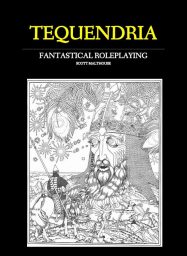 The RPG Tequendria by Scott Malthouse and published through The Trollish Delver Games was released recently on DriveThruRPG as a pay-what-you-want pdf and let me tell you, I immediately wanted to snap it up. Why? Well, the price was right but, that’s not the main reason. The main reason is that it is the only RPG that I know of based directly on the works of Edward John Moreton Drax Plunkett, 18th Baron of Dunsany or, as he’s better known, Lord Dunsany.
The RPG Tequendria by Scott Malthouse and published through The Trollish Delver Games was released recently on DriveThruRPG as a pay-what-you-want pdf and let me tell you, I immediately wanted to snap it up. Why? Well, the price was right but, that’s not the main reason. The main reason is that it is the only RPG that I know of based directly on the works of Edward John Moreton Drax Plunkett, 18th Baron of Dunsany or, as he’s better known, Lord Dunsany.
The system is based on The Trollish Delver Games Unbelievably Simple Roleplaying (USR) system and more on that later. But first, let’s talk briefly about Lord Dunsany. Lord Dunsany had a prolific and popular writing career of 52 years and more than eighty books published – mostly fantasy but, also war memoirs (he served in the first Boer War and World War I). He also worked in the theatre, radio, television, and film. Without him we almost certainly would have had no H.P. Lovecraft and he influenced too many writers to mention. But, let the short list include many early pulp writers such as Robert E. Howard, Clark Ashton Smith, and Manly Wade Wellman and also more recent writers such as Michael Moorcock, Neil Gaiman, and even Guilliermo Del Toro. But, he’s not much read. Even by myself. I don’t know the exact reasons why. Despite his popularity in the early 20th Century, in the second half of the 20th and into the 21st he remains largely unavailable. It wasn’t until about five years ago I ran across his most popular work The King of Elfland’s Daughter, which was a book I’d been on the lookout for for years. Prior to that, the only Dunsany I had read was the collection Beyond the Fields We Know from the Ballantine Adult Fantasy line published in 1972 and read by myself in the early 1980s.
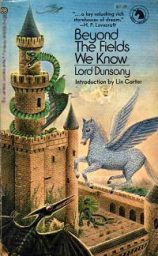
I say don’t know the reason why he fell from popularity because all I have read has been gold. His style simultaneously evokes both biblical writings, the Norse sagas, and the One Thousand and One Nights. The stories themselves always evoke quite a feeling of the strange and sublime. But, perhaps it is his style that fell from favor as it does land hard on modern ears raised on staccato Hemingway influenced prose. All I can say is try it; it’s wonderful. And, if you try this game you can try it because the last third of the book is taken up by three complete Dunsany works: Idle Days on the Yann, Distressing Tale of Thangobrind the Jeweller, and The Fortress Unvanquishable, Save for Sacnoth. If these three stories don’t leave you yearning for more Dunsany, I can’t help you. But, for those who I can help, you can find more Dunsany here. If you haven’t read any Dunsany I recommend that you read at least these three stories first to get the feel of the things.
I said earlier that Tequendria was the only game based directly on Dunsany’s work. But, it’s obvious that the whole of fantasy role playing owes some debt of gratitude to Dunsany. Either through direct influence or through his influence on other writers who served as inspiration for hobby. I challenge anyone to read Distressing Tale of Thangobrind the Jeweller and not come away convinced that the classic Original Dungeons and Dragons thief class was at least partly inspired by the story and arguably more so than Tolkien’s The Hobbit. Thangobrind is clearly a d4 thief.
But, back to the game. As I mentioned before it is based on the Unbelievably Simple Roleplaying (USR) system which lives up to the name. Character generation is as fast and simple as it gets. Each character has three attributes, Action, Wits, and Ego, which are themselves associated with a type of die: d10, d8, or d6. The player chooses which die is associated with each attribute. A characters toughness starts with a Hits score which is equal to the average of their Action and Wits dice. Then the player chooses an archetype (for D&D players, think class). In this case the archetypes are based on Dunsany’s writings. Each archetype has Specialisms, Starting Equipment, and an Ability. Specialisms are skills which aid in accomplishing tasks while Abilities are automatic. For example, a Jewellery Thief has three specialisms (Jewellery Appraisal, Lockpicking, and Sneaking) and one Ability (Greasy Fingers which allows automatic pickpocketing to gain money). A player can either choose an archetype or roll randomly from a table of twenty archetypes. The archetypes include the expected fighter, wizard, thief types of classes but, also include such esoteric things as the telepathic Bathraka Cloudmind and Necronauts who can travel to the Hollow to speak with the dead. Even the more predictable classes have some sort of of odd Dunsany inspired ability or role.
Mechanics as advertised are easy. Tasks are either contested or non-contested. A character rolls the die associated with the tasks attribute, adds modifiers for Specialisms, and possibly equipment associated with the task. If contested the opposing character rolls the same and whomever rolls greater wins the contest. Uncontested tasks roll against a difficulty number set by the GM. Combat is conducted similarly. After an initiative roll, characters proceed in initiative order. Attacks are accomplished by rolling an action die associated with the weapon plus half the character’s level. Defending against an attack a character rolls an action die plus their armor level. If the attacker rolls greater than the defender the attack succeeds and damage is done. There are also a few advanced combat rules but, nothing complicated and all easy to incorporate into the game.
Then there is magic. Any character can cast spells. But, spells have a difficulty and can fail. And, all take a toll on the caster in terms of hits. Some archetypes have Abilities that mitigate this to some degree. The rules say that all characters can cast spells but, do not discuss whether the characters automatically know spells. My take is that this is up to the GM. For myself, I’d make the players work for spells by making them search for rare scrolls and the like. The book lists 27 spells from Create Light, to Raise the Dead, and there are even such spells as to summon swarms of bees.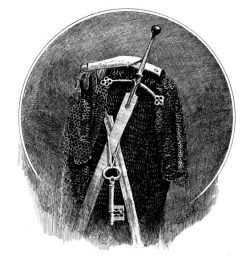
There are short sections on character advancement (by level), healing, travel, environmental dangers (cold, heat, weather), and, of course, treasure (which includes magic items). Then follows a gazetteer that describes the various regions, cities and locations of Tequendria. Each location is briefly described in poetic Dunsanian language that gives a clear feel for each place but, leaves much open to interpretation and GM whimsy. And, if there is any one thing missing from the book that I could wish for, it would be a map showing the relative locations of each place. 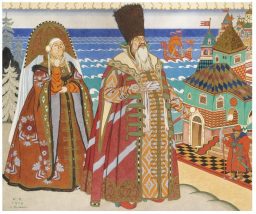 But, I can see why no map was given as the text states, “It is meant to prime the brain, to engage the imagination to spawn your own stories.” And, finally, there is the last section – Creatures of Tequendria. This section presents statistics for GMs to play various monsters and animals from dogs to dragons up to Dunsany-created creatures such as the Gibbelin who move in packs to Hlo-Hlo the God Spider.
But, I can see why no map was given as the text states, “It is meant to prime the brain, to engage the imagination to spawn your own stories.” And, finally, there is the last section – Creatures of Tequendria. This section presents statistics for GMs to play various monsters and animals from dogs to dragons up to Dunsany-created creatures such as the Gibbelin who move in packs to Hlo-Hlo the God Spider.
So, what do I think of it? I like it. It is simple and evocative and works hard to present the minimum needed rather than the most detail. Like Dunsany’s writing it leave much unexplained and up to the imagination of the players. Which, for this venue is just the right approach. I really need to play it now. But, first I have some more Dunsany to read.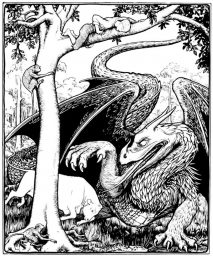
Choosing one of three different dice for one of three attributes is a great idea
-
Yeah, it is neat and it’s one I don’t think I’ve quite seen before.
I can offer my hearty recommendations of his two Shadow Valley/Golden Age of Spain novels, Don Rodriguez and The Charwoman’s Shadow, as those are my favourites among his longer works.
Anyway, this is often repeated and thus borderline tiresome, but I cannot help but mention how Lovecraft recommended that aspiring young writers read the King James Bible, as he thought it the prime influence on Dunsany’s style (and he considered Dunsany to be one of the very finest prose stylists).
-
I’ve read “Charwoman” but not “Rodriguez”. I’m looking forward to doing so.
Poe was Dunsany’s only other confirmed big influence.
BTW, here’s an excellent free source for Dunsany’s fantasy fiction:
http://www.sacred-texts.com/neu/dun/index.htm
-
No Dunsany, but a goodly section of Pulp, and nicely formatted as well:
https://ebooks.adelaide.edu.au/b/burroughs/edgar_rice/
https://ebooks.adelaide.edu.au/h/howard/robert_e/
https://ebooks.adelaide.edu.au/l/lovecraft/hp/
-
Mr. Renninger:
Agreed. I very much like the feel of this book, although I will be adding its influence to my RuneQuest campaign rather than using the USR system. The Archetypes and their abilities are great. I like the descriptions of the spells and the creatures, and the three short stories will be a great way to introduce my players to Lord Dunsany.
I have never read Don Rodriquez, but the Charwoman’s Shadow is very good.
One note about the artwork in this supplement: it includes art by Sidney Sime, who was Dunsany’s favorite artist. Supposedly, Sime complained once to Dunsany that there were no writers interested in his work for their stories. Dunsany told Sime to draw whatever he wanted, and that he, Dunsany, would write stories that included those images. The result was The Book of Wonders in 1912.
Lovecraft was not alone in his opinion of Dunsany’s skill; he was considered to be one of the best writers in the English language in the decade before WWI.
-
Oh yes, Sime’s artwork is great. I intended to put in a mention but, it slipped my mind.
-
Bilibin is also highly underappreciated. An excellent choice as the OTHER artist for the project. Franklin Booth would work as well, but his stuff isn’t PD.
I don’t know why Dunsanay’s larger popularity didn’t carry through past WWI, but I suspect it has something to do with why he’s not immediately accessible for today’s consumers.
His stories don’t pace the way modern stories pace, and there is definitely a language barrier. I grew up reading scriptures, and even so I still need to reset the ol’ frontal lobe when I dive in to Dunsany or, say, William Morris.
I think it’s because those of us who read a lot generally have trained ourselves by repetitious experience to read with the expectation (whether we’re aware of it or not) that we will encountering familiar patterns and formulae, so that when we encounter something that’s off the plot, like Dunsany, our internal story compasses disappear and we’re left adrift until we figure out what kind of paddle we need to get on with the literary journey and at the same time really abuse a metaphor involving boats or whatever.
-
I’ve always wondered whether Dunsany moving on from writing full-on fantasy right around 1918-1919 didn’t have at least something to do with WWI. In fact, from what I’ve seen, it looks like he didn’t write much at all during the War. TALES OF THREE HEMISPHERES came out in 1919 and from what I can tell, all of those stories were written before the War. I think he kind of lost the heart for fantasy in his old style.
What stories would you recommend to someone totally unfamiliar with Lord Dursay?
As I recommended in the review the stories in the game aren’t abad place to start. But, The Book of Wonder is also not a bad place. But, really most anywhere works, he’s that good. Perhaps not his war memoirs.
http://doyleandmacdonald.com/l_wonder.htm
-
Jeffrey and Brian
Thanks! Would Project Gutenberg have them?
xavier
-
You might try this link I posted above, hours earlier:
http://www.sacred-texts.com/neu/dun/index.htm
Strictly Dunsany fantasy. None of his non-fantasy work. All in a nice, readable format.
He wrote a bunch after WWI, to a point where I doubt that anyone has read most of it (with the exception of his scholars). Don’t know, he was apparently one of those who were left bitter and disillusioned after the war. The Blessing of Pan, for example, is pretty much message fiction, and its message and the false dichotomy it was based around came as a real nasty surprise to me. He knew better than that, so I can only imagine that book as a result of bitterness. I’m actually surprised that it isn’t well known in wicca/neopagan circles but I guess that’s the result of nobody expecting that sort of thing from someone like Dunsany.
-
World War One was just a massive, near-mortal blow to the West. It was where Western Civilization tried to commit suicide. WWII was just a continuation.
WWI raised massive existential questions about Christianity, Capitalism, Nationalism and Democracy. Very few seemed to grasp that all of those things had been weaponized and turned against their source. Instead, you had morons and misguided fools gravitating to atheism, Marxism and varous globalist insanities. WWI was a massive wedge that still splits the world to this day.
It would be hard to find a serious author who wasn’t affected. Kipling, Doyle, Haggard, ERB, JRRT, Lewis…all of them were scarred in one way or another. Hodgson died in the trenches. Though it isn’t often brought up, since the relevant passage is often missing from many editions, Kenton in THE SHIP OF ISHTAR was a war- and world-weary veteran of WWI. Hemingway and Robert E. Howard were both products of the post-WWI zeitgeist. The effects of WWI are around us every minute of every day.
Thank you for letting me know about this game,Lord Dunsany has been hard to find and the only book I have read of his was the gods of pegana I found at the library that was under what was most likely the acedemic purpose stuff and not the average viewer stuff